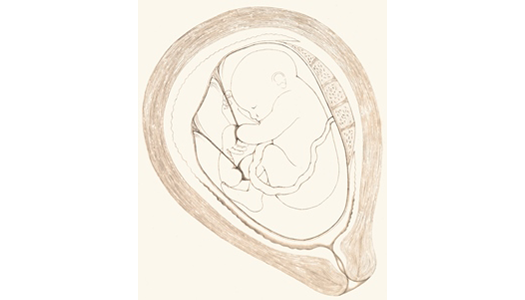The amniotic sac contains fluid that cushions and protects an unborn baby in the womb. Amniotic band syndrome occurs when the inner lining of this sac, called the amnion, tears, causing strands of tissue to wrap around your unborn baby.
Pressure from these wrapped strands creates creases, called amniotic bands, in an unborn baby’s skin. If the bands tighten, there is a risk for limb deformity or loss, as well as severe chest, abdominal and facial defects.
Amniotic Band Syndrome Treatment: Why Choose Us?
Doctors at the Fetal Care Center are among a select few in the country with the expertise to treat amniotic band syndrome in the womb. Our doctors perform a fetoscopic procedure to cut amniotic bands that threaten an unborn baby’s life or limbs.
About Amniotic Band Syndrome
Amniotic band syndrome is rare, affecting approximately 1 out of every 1,200 to 15,000 newborns. The condition affects every baby differently.  Some babies with amniotic band syndrome experience:
Some babies with amniotic band syndrome experience:
- Loss of limbs: Tightly wrapped bands cut off blood flow to certain parts of the body. This leads to the loss of a limb, fingers or toes.
- Fused fingers or toes: Band constrictions meld fingers and toes together.
- Clubfoot: A band compresses a nerve in the lower leg, causing the foot to twist out of position.
- Abdominal problems: Abdominal band constrictions create a hole in the muscle and skin covering the stomach. Intestines and other organs may poke through this hole. This condition is known as gastroschisis.
- Heart problems: Band constrictions around the chest may cause heart defects.
- Cleft lip or cleft palate: Facial bands can cause gaps to form on the lip or roof of the mouth.
Causes of Amniotic Band Syndrome
Amniotic band syndrome has no known cause. Occasionally, trauma to the abdominal area during pregnancy causes the amnion—the sac or bag that holds the baby and amniotic fluid—to rupture. Because the condition is not genetic, it is extremely unlikely to happen again in a future pregnancy.
Diagnosing Amniotic Band Syndrome
Our ultrasound experts use 3-D ultrasound technology to detect amniotic band syndrome in unborn babies. A maternal-fetal medicine specialist is with you during this procedure to quickly provide information about your unborn baby’s condition and treatment options. Learn more about high-risk pregnancy tests.
Treating Amniotic Band Syndrome
Treatment depends on how the amniotic bands affect your unborn baby’s development. If a band poses a serious threat to your unborn baby’s health, your doctor may recommend fetal surgery.
Doctors at the Fetal Care Center are among a select few in the nation who perform fetoscopic treatment for amniotic band syndrome. This procedure occurs in utero, meaning your unborn baby remains in the womb during surgery. Learn more about fetoscopy.
After childbirth, pediatric specialists at St. Louis Children’s Hospital care for babies who have problems due to amniotic band syndrome. These problems may include clubfoot, cleft lip or cleft palate. Learn more about pediatric specialties.
Contact Us
To make an appointment with a Washington University fetal care specialist at the Women & Infants Center, call 866.867.3627.